Dusky Dolphin
Lagenorhynchus obscurus
Communicates using whistles, squeaks and clicks!
Advertisement
Dusky Dolphin Scientific Classification
- Kingdom
- Animalia
- Phylum
- Chordata
- Class
- Mammalia
- Order
- Cetacea
- Family
- Delphinidae
- Genus
- Lagenorhynchus
- Scientific Name
- Lagenorhynchus obscurus
Read our Complete Guide to Classification of Animals.
Dusky Dolphin Conservation Status
Dusky Dolphin Facts
- Prey
- Anchovies, Sardines, Squid
- Name Of Young
- Calf
- Group Behavior
- Pod
- Fun Fact
- Communicates using whistles, squeaks and clicks!
- Estimated Population Size
- Not Known
- Biggest Threat
- Hunting and commercial fishing
- Most Distinctive Feature
- Rounded black beak and tall, curved dorsal fin
- Gestation Period
- 11 months
- Habitat
- Cooler waters near continental shelves
- Predators
- Killer Whales, Sharks, Humans
- Diet
- Carnivore
- Average Litter Size
- 1
- Lifestyle
- Diurnal/Nocturnal
- Common Name
- Dusky Dolphin
- Number Of Species
- 3
- Location
- Across the southern hemisphere
- Slogan
- Communicates using whistles, squeaks and clicks!
- Group
- Mammal
Dusky Dolphin Physical Characteristics
- Color
- Grey
- Blue
- Black
- White
- Skin Type
- Smooth
- Top Speed
- 23 mph
- Lifespan
- 18 - 25 years
- Weight
- 80kg - 120kg (176lbs - 264lbs)
- Length
- 1.6m - 2.1m (5ft - 7ft)
- Age of Sexual Maturity
- 4 - 5 years
- Age of Weaning
- 18 months
View all of the Dusky Dolphin images!
The Dusky Dolphin is a small species of dolphin that is found inhabiting the cooler waters along continental shelves throughout the southern hemisphere. This distinctive-looking cetacean is closely related to other large marine animals, including other dolphins, porpoises, and whales, but despite their fish-like appearance Dusky Dolphins are true mammals that both breathe air in and out of their lungs and also suckle their young on milk produced by the mother’s mammary glands. Dusky Dolphins are widespread throughout the southern hemisphere, with three species being recognized that have been grouped by their geographical range, with one found off the coast of South America, one near South Africa and in the Indian Ocean, and another inhabits deeper waters close to New Zealand. Sadly, however, despite being locally common in certain areas, Dusky Dolphin populations have declined throughout much of their natural range primarily due to threats caused by increasing levels of human activity.
Evolution and Origins
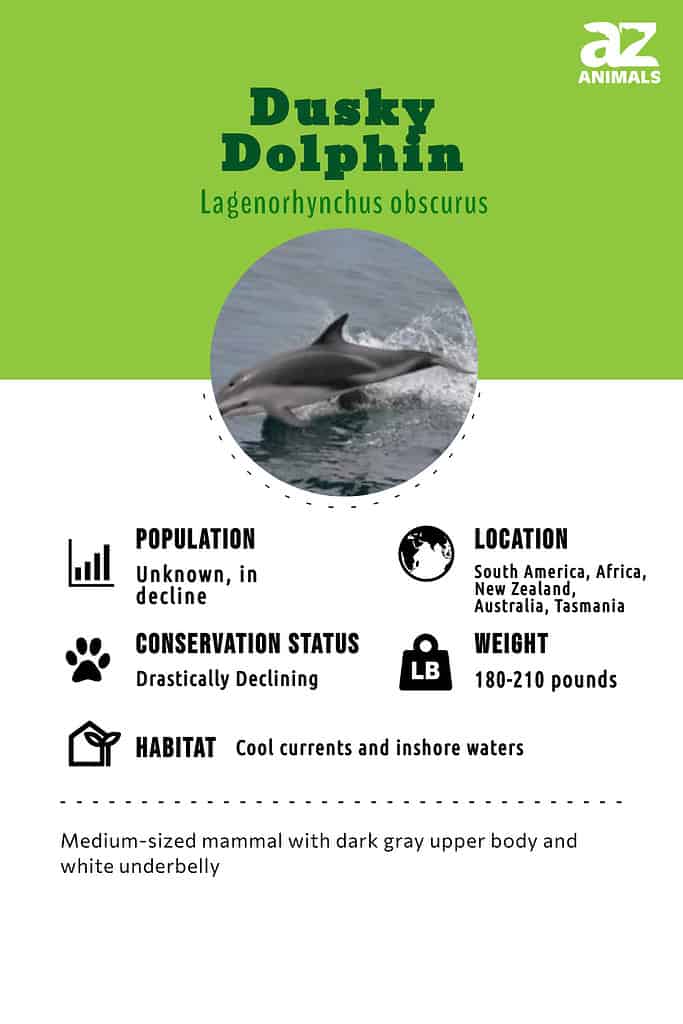
The evolutionary history of the Dusky Dolphin (Lagenorhynchus obscurus) is a fascinating subject that has been studied extensively by researchers and marine biologists. Despite being one of the most elusive and enigmatic species in the cetacean family, scientists have managed to uncover some interesting facts about its origins over time.
According to genetic studies, Dusky Dolphins are closely related to other members of the Lagenorhynchus genus, such as the Pacific white-sided dolphin and Peale’s dolphin. These dolphins all share similar physical characteristics, including their small size, streamlined bodies, and distinctive black-and-white markings.
Based on fossil records and molecular data analysis, it is believed that the ancestors of modern-day Dusky Dolphins diverged from their common ancestor with other Lagenorhynchus species around 6-7 million years ago. Over time, these early dolphins evolved unique adaptations that allowed them to thrive in their specific habitats along coastal regions throughout South America.
Today, Dusky Dolphins are found primarily in temperate waters off the coastlines of New Zealand, Chilean Patagonia, Peru’s Ballestas Islands, and Argentina’s Atlantic coast. They have adapted well to these environments through specialized hunting techniques like strand feeding where they herd fish into shallow water before attacking them collectively; making them an important part of local ecosystems within those areas.
Anatomy and Appearance
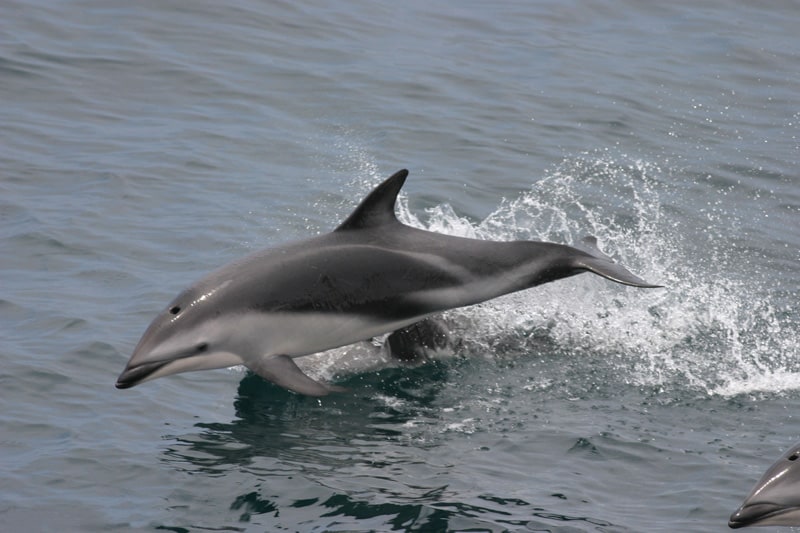
A Dusky Dolphin can weigh up to 210 pounds.
©Protected Resouces Division, Southwest Fisheries Science Center, La Jolla, California – Public Domain
The Dusky Dolphin is the smallest of the world’s 33 different species of dolphin, growing to under two meters in length and generally weighing less than 100kg. Like other species of cetacean, Dusky Dolphins have a smooth and hairless, streamlined body that helps them to glide through the water and is powered by their two tail flukes which lay horizontally rather than vertically like those of fish. The upper side of their bodies is either dark grey or blue-black in color and is separated from their light grey to white underside by a grey line that runs from their beak to the base of their tail. Dusky Dolphins also have two light grey lines which run diagonally from their tail to their dorsal fin, which is tall and curved to help them to change direction quickly in the water. The beak of the Dusky Dolphin is black and more rounded in shape than those of other dolphin species and contains between 24 and 36 pairs of sharp, cone-shaped teeth that are ideal for catching slippery and fast-moving prey.
Distribution and Habitat

Dusky Dolphins like cool currents
Dusky Dolphins tend to be found in cool to temperate waters (10 – 18 degrees centigrade) close to continental shelves throughout the southern hemisphere and seem to prefer shallower rather than deep water regions (although this can vary depending on the location and time of year). Although they are not generally known to participate in seasonal migrations, Dusky Dolphins can travel vast distances across the ocean and at great speed in search of food. The three Dusky Dolphin species have been classified by the regions in which they live, with the highest populations found off the coast of South America, South-Western Africa, and around New Zealand. There are also populations known to occur in the waters close to Argentina along with around the Falkland Islands further south. Despite their wide range and distribution throughout the southern hemisphere, Dusky Dolphin populations have been decreasing mainly due to interaction with humans, including being hunted for their meat and getting caught in the nets that are used to catch the shoaling fish which the Dusky Dolphins hunt.
Behavior and Lifestyle

Dusky Dolphins are highly social and intelligent animals.
The exact behaviors and habits of Dusky Dolphins depend on the species, and where they live however, they generally spend time close to the shore resting during the day in small groups that consist of between ten and twenty individuals. As night falls, these small groups begin to travel further away from land to feed and form pods consisting of up to 1,000 individuals that include both male and female members in order to work together to corner shoals of fish.
Dusky Dolphins are incredibly sociable animals and can be seen playing, grooming, and leaping together after feeding before breaking up into their smaller groups again to return closer to the coast to rest. Although they are able to dive for up to 90 seconds at a time like other marine mammals, Dusky Dolphins must keep returning to the water’s surface to breathe and expel old air and water from their lungs via the single blow-hole that located on the top of their heads. They are highly intelligent animals and are often seen leaping out of the water before diving back in after gliding through the air for a few seconds. This technique is known as porpoising and enables the Dusky Dolphin to breathe without having to slow down when chasing prey.
Reproduction and Life Cycles
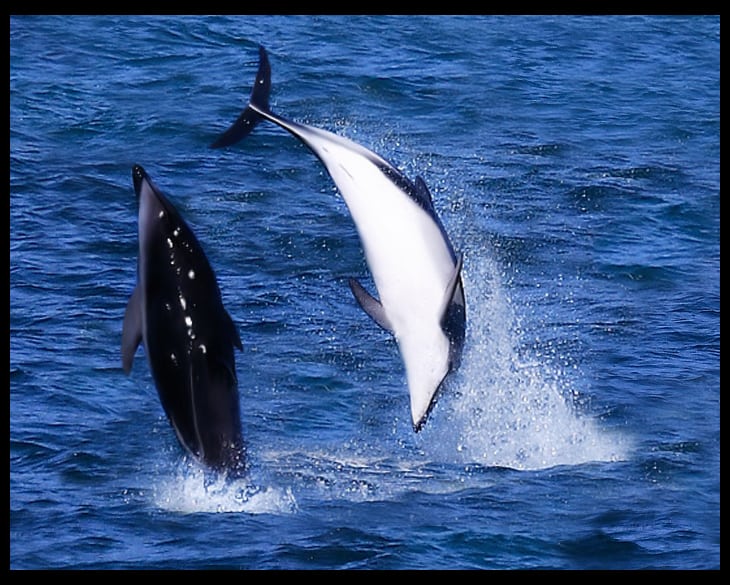
Dusky Dolphins can be seen throughout the southern hemisphere.
Despite being relatively widespread across the southern hemisphere, the fast-moving nature of the Dusky Dolphin has meant that it can often be hard to study these animals in the wild, and quite little is therefore known about their lifespans in general. Most Dusky Dolphin calves tend to be born towards the end of the winter and in the early summer months between October and February, when the female gives birth to a single offspring after a gestation period that lasts for around 11 months.
The Dusky Dolphin calf is fed on the nutritious milk provided by its mother until it is then taught to hunt by her after about a year. Calves tend to remain close to their mother until they are around three years old, when they leave to join a pod of their own (males with often form bachelor groups), and the female is then able to mate again. Dusky Dolphins are thought to be able to breed when they are between the ages of four and five and are thought to live for an average of 20 years.
Diet and Prey
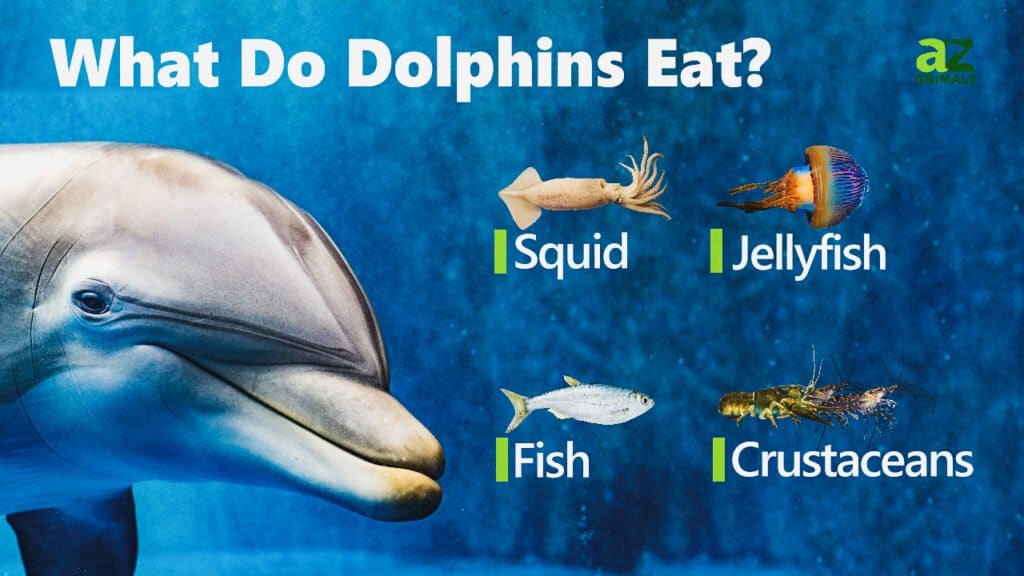
The Dusky Dolphin is a carnivorous animal that only feeds on other animals in order to gain the nutrients that it needs to survive. By congregating in large groups, Dusky Dolphins are able to trap vast schools of fish so that they have the best opportunity to feed by traveling through the waters in a line and pushing the shoal into an area where it is trapped. Prey depends largely on the area in which the Dusky Dolphins are feeding, but they most commonly consume anchovies, sardines, and mackerel in shallower waters, squid at mid-depths, and larger prey, including hake and octopus in the deeper ocean. Although Dusky Dolphins have excellent hearing and are able to see remarkably well through the water, it is actually a specially evolved system that these animals use which both helps them to locate prey and to avoid upcoming obstacles. By producing a rapid series of clicking noises, the Dusky Dolphin’s brain is then able to translate the clicks that bounce off things ahead (such as fish) into a mental sound map of the surrounding area and therefore knows exactly where to find food.
Predators and Threats

The commercial fishing industry is the biggest threat to dolphins.
©OlegRi/Shutterstock.com
The relatively large size, sociable nature, and sheer speed of the Dusky Dolphin mean that it has very few predators that hunt it in its natural environment. Pods of Killer Whales (to which they are related) are the main predators of the Dusky Dolphin, along with some large species of shark that venture into the shallower, coastal waters. The biggest threat to the world’s Dusky Dolphin populations, though, is people encroaching more and more on their natural habitats, usually in the form of commercial fishing. As humans are fishing for the same shoaling fish as the Dusky Dolphins, it often leads to them being caught up in vast nets where they can quickly become trapped. Other reasons for the decline in Dusky Dolphins include the fact that they are also hunted in some areas (particularly Peru) for their meat and are injured by large boats that hit them.
Interesting Facts and Features

Dusky dolphins and common dolphins are friends.
©Sergey Uryadnikov/Shutterstock.com
The Dusky Dolphin is thought to be one of the most intelligent animal species in the world and even communicates with other individuals using their own language, which consists of a series of whistles, clicks, and squeaks. The unique body shape of the Dusky Dolphin means that it is incredibly flexible and, in fact, the most agile species of dolphin in the world. They are often seen leaping out of the water both when swimming and playing, and the noise that is caused by them diving back into the water is able to travel for up to 1km through the water and up to 3km through the air. Dusky Dolphins are known to be incredibly sociable animals with sick or injured individuals helped by others that push them towards the surface so the vulnerable individual is able to breathe. Along with being seen together in their own pods, Dusky Dolphins are also known to interact with other cetaceans, including Common Dolphins, which they feed alongside.
Relationship with Humans
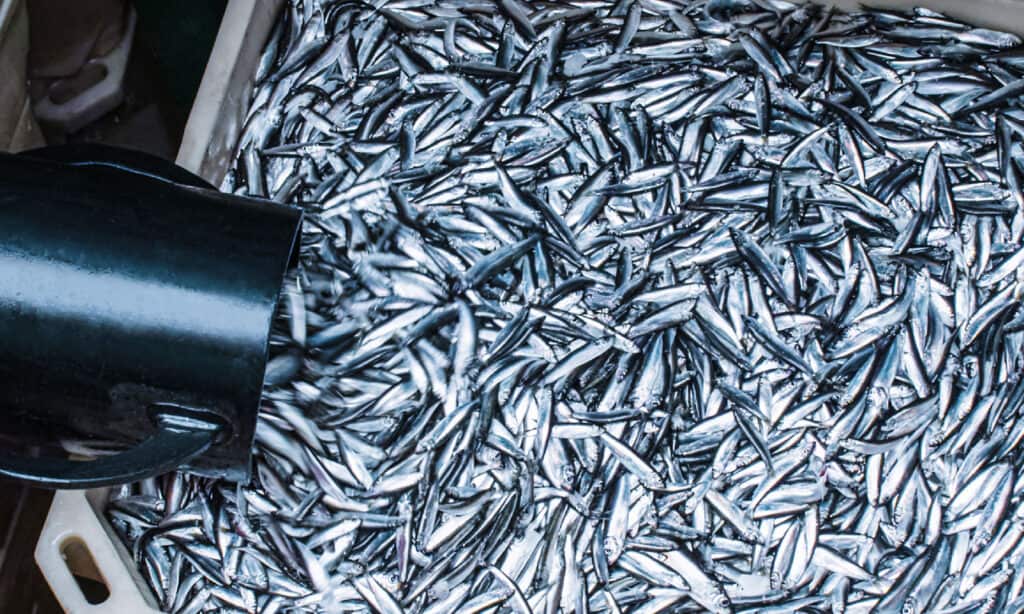
Turtles, sharks, and dolphins are caught by the thousands in commercial fishing nets.
©Gorodenkoff/Shutterstock.com
Despite being one of the most intelligent animals in the world, the increasing amount of man-made obstacles, such as boats and rigs that litter the sea, has led to a decline in Dusky Dolphin populations as they are often hit by them. Populations around South America have also suffered greatly from hunting by people for their flesh which is used both as bait for fish and for human consumption. A study carried out between 1991 and 1993 revealed that 7,000 Dusky Dolphins were captured each year, and although the hunting of dolphins has been recently banned, they are still commonly hunted as food. The issue, however, that most affects all Dusky Dolphin populations is the fact that they are often caught by accident in large fishing nets that are targeting the same fish that the dolphins are. However, in a growing number of places around the world, watching the acrobatic Dusky Dolphin is becoming increasingly popular with tourists and bringing awareness to the threats that they face.
Conservation Status and Life Today

Dusky Dolphin numbers are drastically declining.
Today, the Dusky Dolphin is listed by the IUCN as being Data Deficient which means that although certain populations in certain areas are well reported, little is really known about those individuals that inhabit unpopulated regions. However, their numbers are known to be drastically declining throughout the southern hemisphere, primarily due to the increasing levels of human activity in their native environments. Despite hunting them being banned, they are still caught in nets and trawlers by the thousands on a yearly basis.
View all 110 animals that start with DDusky Dolphin FAQs (Frequently Asked Questions)
Are Dusky Dolphins herbivores, carnivores, or omnivores?
Dusky Dolphins are Carnivores, meaning they eat other animals.
What Kingdom do Dusky Dolphins belong to?
Dusky Dolphins belong to the Kingdom Animalia.
What class do Dusky Dolphins belong to?
Dusky Dolphins belong to the class Mammalia.
What phylum to Dusky Dolphins belong to?
Dusky Dolphins belong to the phylum Chordata.
What family do Dusky Dolphins belong to?
Dusky Dolphins belong to the family Delphinidae.
What order do Dusky Dolphins belong to?
Dusky Dolphins belong to the order Cetacea.
What type of covering do Dusky Dolphins have?
Dusky Dolphins are covered in Smooth skin.
What genus do Dusky Dolphins belong to?
Dusky Dolphins belong to the genus Lagenorhynchus.
Where do Dusky Dolphins live?
Dusky Dolphins are found across the southern hemisphere.
In what type of habitat do Dusky Dolphins live?
Dusky Dolphins live in cooler waters near continental shelves.
What are some predators of Dusky Dolphins?
Predators of Dusky Dolphins include killer whales, sharks, and humans.
How many babies do Dusky Dolphins have?
The average number of babies a Dusky Dolphin has is 1.
What is an interesting fact about Dusky Dolphins?
Dusky Dolphins communicate using whistles, squeaks, and clicks!
What is the scientific name for the Dusky Dolphin?
The scientific name for the Dusky Dolphin is Lagenorhynchus obscurus.
What is the lifespan of a Dusky Dolphin?
Dusky Dolphins can live for 18 to 25 years.
How many species of Dusky Dolphin are there?
There are 3 species of Dusky Dolphin.
What is the biggest threat to the Dusky Dolphin?
The biggest threats to the Dusky Dolphin are hunting and commercial fishing.
How many Dusky Dolphins are left in the world?
The population size of the Dusky Dolphin is unknown.
How fast is a Dusky Dolphin?
A Dusky Dolphin can travel at speeds of up to 23 miles per hour.
How to say Dusky Dolphin in ...
Thank you for reading! Have some feedback for us? Contact the AZ Animals editorial team.
Sources
- David Burnie, Dorling Kindersley (2011) Animal, The Definitive Visual Guide To The World's Wildlife
- Tom Jackson, Lorenz Books (2007) The World Encyclopedia Of Animals
- David Burnie, Kingfisher (2011) The Kingfisher Animal Encyclopedia
- Richard Mackay, University of California Press (2009) The Atlas Of Endangered Species
- David Burnie, Dorling Kindersley (2008) Illustrated Encyclopedia Of Animals
- Dorling Kindersley (2006) Dorling Kindersley Encyclopedia Of Animals
- David W. Macdonald, Oxford University Press (2010) The Encyclopedia Of Mammals
- Dusky Dolphin Information, Available here: http://marinebio.org/species.asp?id=365
- About Dusky Dolphins, Available here: http://animaldiversity.ummz.umich.edu/site/accounts/information/Lagenorhynchus_obscurus.html
- Dusky Dolphin Conservation, Available here: http://www.iucnredlist.org/apps/redlist/details/11146/0

















